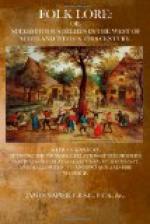It was believed that, when peeling onions, if an onion were stuck on the point of the knife which was being used, it would prevent the eyes being affected.
The common Fern, it was believed, was in flower at midnight on St. John’s Eve, and whoever got possession of the flower would be protected from all evil influences, and would obtain a revelation of hidden treasure.
St.-John’s-Wort. In heathen mythology the summer solstice was a day dedicated to the sun, and was believed to be a day on which witches held their festivities. St.-John’s-Wort was their symbolical plant, and people were wont to judge from it whether their future would be lucky or unlucky; as it grew they read in its progressive character their future lot. The Christians dedicated this festive period to St. John the Baptist, and the sacred plant was named St.-John’s-Wort or root, and became a talisman against evil. In one of the old romantic ballads a young lady falls in love with a demon, who tells her
“Gin you wish to be Leman
mine,
Lay aside the St.-John’s-wort
and the vervain.”
When hung up on St. John’s day together with a cross over the doors of houses it kept out the devil and other evil spirits. To gather the root on St. John’s day morning at sunrise, and retain it in the house, gave luck to the family in their undertakings, especially in those begun on that day. Plants with lady attached to their names were in ancient times dedicated to some goddess; and in Christian times the term was transferred to the Virgin Mary. Such plants have good qualities, conferring protection and favour on their possessors.
From the earliest times the Rose has been an emblem of silence. Eros, in the Greek mythology, presents a rose to the god of silence, and to this day sub rosa, or “under the rose,” means the keeping of a secret. Roses were used in very early times as a potent ingredient in love philters. In Greece it was customary to leave bequests for the maintenance of rose gardens, a custom which has come down to recent times. Rose gardens were common during the middle ages. According to Indian mythology, one of the wives of Vishna was found in a rose. In Rome it was the custom to bless the rose on a certain Sunday, called Rose Sunday. The custom of blessing the golden rose came into vogue about the eleventh century. The golden rose thus consecrated was given to princes as a mark of the Roman Pontifs’ favour. In the east it is still believed that the first rose was generated by a tear of the prophet Mahomet, and it is further believed that on a certain day in the year the rose has a heart of gold. In the West of Scotland if a white rose bloomed in autumn it was a token of early death to some one, but if a red rose did the same, it was a token of an early marriage. The red rose, it was said, would not bloom over a grave. If a young girl had several lovers, and




